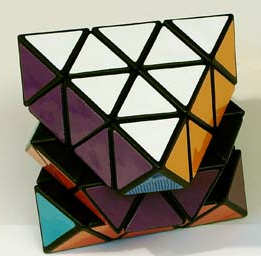(Outdated) A Solution to the Face-Turning Octahedron
Last modified March 25, 2020.

Source: Wikimedia Commons
General Puzzle Notes
The face-turning octahedron (FTO) is much more interesting than its corner-turning relative, simply because the corner-turning variant reduces into a hybrid of a pyraminx and an edges-only 3x3x3, which makes it much easier to solve.
Solution found: Feb 26, 2016
General Solving Overview
The puzzle can be solved using just sledgehammer and sune (and optionally, their inverses). We define sledgehammer as R’ L R L’ and sune as R U R’ U R U R’ U (note the extra U at the end).
The solution steps are as follows:
- Fix corners, using sledgehammer if needed.
- Fix centers using setup moves and sune and/or antisune.
- Fix edges using sune and/or antisune.
This is definitely not the most optimal solution, but it is quite nice since there are only two algorithms needed. To perform these algorithms we must hold the puzzle such that the UF edge faces us.
Step 1: Fix Corners
The first layer (bottom layer) corners are very intuitive, especially if one knows how to solve the skewb.
Essentially, any corner can be picked to be the first corner and placed on the bottom layer. A second corner can be placed next to this one, using sledgehammer if necessary. The third corner can then be placed in a similar way as the second corner.
To complete the last-layer corners, we just need to orient them and adjust the U face (AUF).
Find the colour that all last-layer corners have in common. This colour will be the colour of the current U side. If only one corner is oriented, turn the puzzle so that the two unoriented corners are in the URF and DFR positions, and the oriented corner is in the FLU position. Then do sledgehammer. Rotating the puzzle back and AUFing will then solve all the corners.
Step 2: Fix Centers
Note that sune cycles the U-face centers 90 degrees clockwise. Likewise, antisune cycles the U-face centers 90 degrees counterclockwise.
The very first few centers can probably be solved just by performing slice moves, but the centers afterwards will need the sunes/antisunes and setup moves to complete.
Step 3: Fix Edges
What sune does in this step is cycle the U-face edges 90 degrees clockwise. Likewise, antisune cycles the U-face edges 90 degrees counterclockwise.
Note that because the U-face centers are also cycled when using sune/antisune (see Step 2), we cannot use setup moves now. This means that we can only use cube rotations and repeated applications of the algorithm, making this step much more tedious.
Go back to Articles